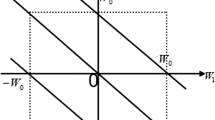Abstract
In this paper, a new method for extracting the system phase from the bispectrum of the system output has been proposed. This is based on the complete bispectral data computed in the frequency domain and modified group delay. The frequency domain bispectrum computation improves the frequency resolution and the modified group delay reduces the variance preserving the frequency resolution. The use of full bispectral data also reduces the variance as it is used for averaging. For the proposed method at a signal to noise ratio of 5dB, the reduction in root mean square error is in the range of 1.5–7 times over the other methods considered.
Similar content being viewed by others
References
Raghuveer M.R. and Nikias C.L. (1987). Bispectrum estimation: a digital signal processing framework. Proc. IEEE 75(7): 869–89
Holambe R.S., Ray A.K. and Basu T.K. (1996). Signal phase recovery using the bispectrum. Signal Process. 55: 321–337
Nikias C.L. and Petropulu A.P. (1993). Higher Order Spectral Analysis: A Non-linear Signal Processing Framework. Signal Processing Series. Prentice-Hall, Englewood Cliffs
Narasimhan S.V., Reddy G.R., Plotkin E.I. and Swamy M.N.S. (1992). Phase estimation by bispectrum: A group delay approach. Signal Process. 27(1): 79–86
Raghuveer M.R. and Nikias C.L. (1985). Bispectrum estimation: A parametric approach. IEEE Trans. Acoust. Speech Signal Process. 33(4): 1213–1229
Pan R. and Nikias C.L. (1988). The Complex cepstrum of higher order cumulants and non-minimum phase system identification. IEEE Trans. Acoust. Speech Signal Process. 36(2): 186–204
Narasimhan S.V., Reddy G.R., Plotkin E.I. and Swamy M.N.S. (1992). Bispectrum based mixed phase system identification by AR/ARMA models: AR/ARMA models: a group delay approach. IEEE Trans. Circuits Syst 39(9): 671–674
Yegnanarayana B., Saikia D.K. and Krishnan T.R. (1984). Significance of group delay functions in signal reconstruction from spectral magnitude or phase. IEEE Trans. ASSP 32(3): 610–623
Nikias, C.L., Mendel, J.M.: Signal processing with higher order spectra. IEEE Signal Process. Mag. pp. 10–37, July (1993)
Yegnanarayana B. and Murthy H.A. (1992). Significance of group delay functions in spectrum estimation. IEEE Trans. Signal Process. 40(9): 2281–2289
Matsuoka T. and Ulrych T.J. (1984). Phase estimation using the bispectrum. Proc. IEEE 72: 1403–1411
Benveniste, M.G., Ruget, G.: Robust identification of non- minimum phase system: Blind adjustment of linear equalizer in data communications. IEE Trans. Automat. Control, AC-25 (June), pp. 385–398 (1980)
Oppenheim A.V., Hayes M.H. and Lim J.S. (1982). Iterative procedures for signal reconstruction from Fourier Transform phase. Opt. Eng. 21(February): 122–127
Subba Rao, T., Gabbar, M.M.: An introduction to bispectral analysis and bilinear time series models. In: Brillinger D.R. et al. (eds.) Lecture Notes on Statistics, vol. 24, Springer, Berlin (1984)
Yegnanarayana: Speech analysis by pole-zero decomposition of short time spectra. Signal Process. 17, 141–150 (1989)
Yamani: Flaw impulse response estimation in ultrasonic non-destructive evolution using bi-cepstra. NDT&E Int. vol. 40, pp. 57–61 (2007)
Hazarathaiah, M., Narasimhan, S.V.: Phase estimation based on bispectrum and modified group delay. In: Signal Processing and Communication (SPCOM 2001), Bangalore, Organized by the IEEE Signal Processing Society, Bangalore Chapter
Narasimhan S.V. and Giridhar P.V.S. (2000). Improved system blind identification based on second order cyclostatinary statistics: A group delay approach. Academy Proc. Eng. Sci. SADHANA 25(122): 85–96
Narasimhan S.V., Hazarathaiah M. and Giridhar P.V.S. (2005). Channel blind identification based on cyclostationarity and group delay. Signal Process. 85(7): 1275–1286
Petropulu, A.P., Abeyratne, U.R.: System reconstruction from higher order spectra slices. IEEE Trans. Signal Process. 45(9) (1997)
Author information
Authors and Affiliations
Corresponding author
Rights and permissions
About this article
Cite this article
Narasimhan, S.V., Basumallick, N. & Chaitanya, R. Improved phase estimation based on complete bispectrum and modified group delay. SIViP 2, 261–274 (2008). https://doi.org/10.1007/s11760-008-0054-7
Received:
Revised:
Accepted:
Published:
Issue Date:
DOI: https://doi.org/10.1007/s11760-008-0054-7




